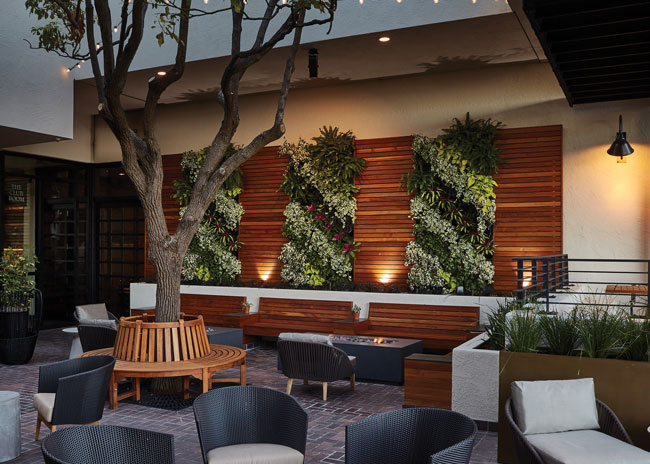If ever there was a time when the soothing, healing touch of nature on the human spirit was needed, it could be now. Designers are perfectly positioned to help deliver that magic touch. Bringing the outdoors in for desk- and tech-tethered consumers, designers are embracing biophilic design for its enduring aesthetic appeal and, increasingly, for its well-documented benefits to the human psyche.
Based on the concept of biophilia, which posits that humans have an inborn need for contact with nature and that this connection is essential to our health and well-being, biophilic design is all about integrating nature into the built environment. It’s not new — designers and architects have long turned to nature for inspiration. But in America where the Environmental Protection Agency estimates the average consumer now spends 93% of their time indoors (and that was before the pandemic), it has become a driving and impactful trend.
“Biophilic design is gaining more traction, particularly as people realize that it can fundamentally shift people’s experience of a space,” says Bill Browning, founding partner at Terrapin Bright Green (TPG), a green building and real estate consultancy and design firm with offices in Washington, D.C., and New York. “A lot of it is what we intuitively do and intuitively love. But what’s growing is the science behind it, which is helping to unpack and explain why we respond to things the way that we do and is demonstrating measurable benefits to both people and businesses.”
Those benefits, Browning says, range from increased productivity, decreased stress and higher morale among employees to faster recoveries for patients when elements of nature are integrated into work and healthcare spaces. In a study on the economic benefits of biophilic design, TPG cites scientific research that claims providing access to plants, natural views, natural light and other biophilic design elements can reap savings of more than $2,000 per employee per year in lost corporate office productivity. And more than $93 million could be saved annually in healthcare costs as a result of providing patients with views of nature, according to the research.
Hospitality and retail, too, are on board. At retail, studies cited by TPG confirm that designing settings with plenty of plant material, views to nature and ample daylight “significantly boosts the image perception and economic viability of business within those segments.”
Consumers reported they’re willing to pay more, visit more frequently and spend more time per visit in businesses that integrate biophilic design elements.
“Hotel lobbies are one example,” says Browning, whose firm researched and developed 14 patterns of biophilic design. “Biophilic design changes people’s patterns of use, increasing dwell time. We did an observational study of lobbies in New York City, some with conventional designs and some that had taken strong biophilic design approaches. We saw a 36% increase in the number of active and passive users in lobbies with biophilic elements. Any time you can increase dwell time in retail or in that type of hospitality setting, which typically includes F&B options, you have a much better chance of getting people to buy.”
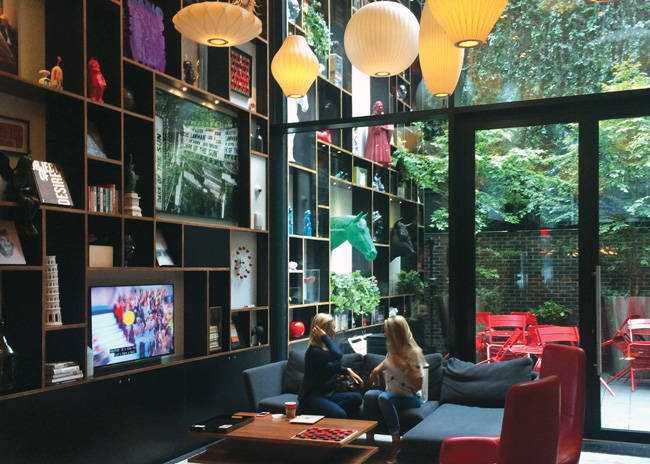 citizenM, Times Square, image courtesy of Catie Ryan.
citizenM, Times Square, image courtesy of Catie Ryan.
citizenM, a Dutch hotel brand with a property in New York City’s Times Square, was among the lobbies studied. Designed as a “living room plaza,” the space has double-height ceilings, floor-to-ceiling glass walls for views of a garden courtyard, natural materials, organic shapes and a variety of seating styles. “We found that 54% of the people who use that lobby are active users, not just passing through,” Browning says. “That’s one of the highest percentages we’d ever seen. We did interviews and discovered that people like the space so much, they come from the surrounding neighborhood to have a coffee or a drink at the lobby bar. They feel good there, and part of that has to do with both subtle and direct connections to nature in the heart of the city.”
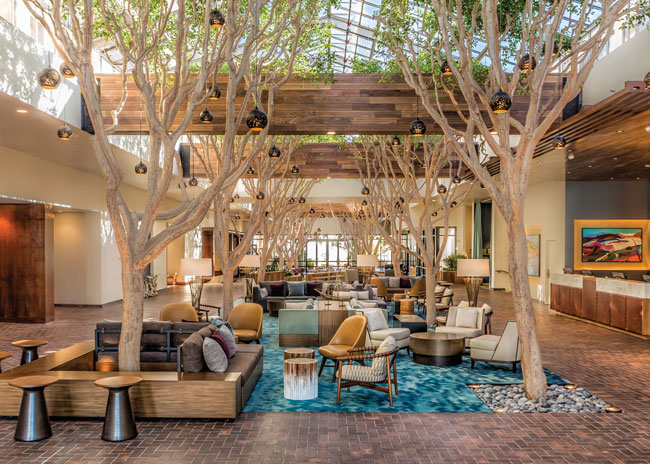 A double row of real trees in the lobby of a former DoubleTree Hotel provided a strong biophilic design springboard for the Portola Hotel & Spa in Monterey, Calif. They inspired the designers to simulate nature through colors, materials, lighting and textures to create a sense of place. Image courtesy of Jake Perl
A double row of real trees in the lobby of a former DoubleTree Hotel provided a strong biophilic design springboard for the Portola Hotel & Spa in Monterey, Calif. They inspired the designers to simulate nature through colors, materials, lighting and textures to create a sense of place. Image courtesy of Jake Perl
Plants — With Purpose
The most obvious and basic biophilic design approach is also the simplest: Add more green plants to interior spaces as well as to entryways, patios, rooftops and other exterior guest service areas. Potted plants strategically placed throughout restaurant interiors are an easy and affordable tactic taken by many operators to bring nature inside. Browning points out that even restaurants with small footprints and small budgets can take this most basic step and provide benefits to both guests and staff by doing so.
Rob Polacek, co-founder and partner at San Francisco-based design firm RoseBernard Studio, agrees. “We’re seeing a huge influx of bringing plants and plantings and natural light into all types of hospitality and restaurant environments,” he says. “I hope it’s not a passing trend. Being around nature and plants makes people feel happy, and restaurants are supposed to make us feel happy.”
Polacek adds that there are other strong reasons for strategically integrating more plants and biophilic design elements into restaurant interiors. Top among them are opportunities to create a sense of place and to inject natural connections to the food being served. Those were objectives the RoseBernard team had in mind when designing restaurant, lounge and market spaces at the Grand Hyatt SFO at the San Francisco International Airport.
“The restaurant space overlooks the tarmac with beautiful views beyond and tons of natural light. We incorporated a lot of native California plants into the restaurant environment to create a sense of truly being in the Bay Area,” Polacek says. “If guests’ experience is limited to a stay at the airport hotel, or they’re visiting during delays between flights, they can still experience the natural beauty of the area and feel like they’re in an authentic Northern California restaurant. And that translates down to the plate. We worked closely with the chef to make sure that we were making the right kinds of connections to the menu and cocktail program through herbs, plants, materials and colors used. Biophilic design is becoming much more holistic. It’s not just about putting a potted plant in the corner or hanging up pictures of trees and saying, ‘OK, we’ve checked that box.’”
Trees — real ones — provided strong and authentic biophilic design inspiration for another Polacek project, the Portola Hotel & Spa in Monterey, Calif. Originally a DoubleTree Hotel, the property has two rows of live trees planted in an atrium-style lobby.
“When we took on the Portola project, the owners were worried we might suggest getting rid of the trees. Rather, they were the inspirational springboard for how we thought about the design and materials for the entire hotel and its F&B spaces,” Polacek says. “It was such a strong connection to nature. They made us think about how we use color, texture and pattern to create a sense of place. They inspired us to simulate the natural environment into the designed environment in many ways, from carpet patterns that evoke windswept beaches and ocean hues to lighting solutions that create beautiful filtered light that changes throughout the course of the day.”
The project included an outdoor terrace area just outside Jacks Monterey, the hotel’s marquee restaurant. Previously used as more of a walkway, lacking in both seating and character, the area is now an extension of the restaurant.
For an indoor-outdoor feel, the design team installed four large, vertical garden walls, three of which alternate with teak slat walls. A fourth is planted with some of the same herbs used in the kitchen and at the bar. “There’s a purpose and a connection behind them,” Polacek says. “The green walls create a visual and acoustical environment that’s softer for guests than the original stucco walls, but they also promote the cuisine and craft cocktail program. Those types of strong connections, that make sense from both a design and a branding/operations standpoint, create more justification for investing in these types of elements.”
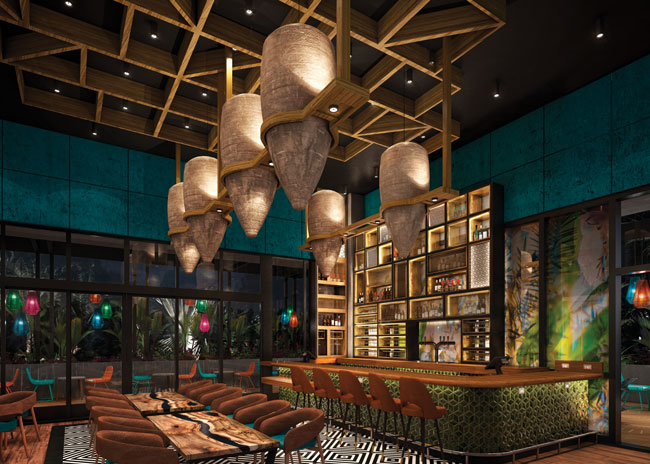 The design for Jarana evokes an indoor-outdoor Peruvian market. It features oversized Pisco jar lighting, modern trellis work from which ferns and succulents will hang, fractal patterns, warm woods, and glass walls overlooking outdoor seating areas with rattan pendants and tropical plantings. Image courtesy of The McBride Company
The design for Jarana evokes an indoor-outdoor Peruvian market. It features oversized Pisco jar lighting, modern trellis work from which ferns and succulents will hang, fractal patterns, warm woods, and glass walls overlooking outdoor seating areas with rattan pendants and tropical plantings. Image courtesy of The McBride Company
Green Grow the Walls
Indeed, the past several years have seen a dramatic rise not only in the use of plants in general in restaurant designs but in the use of living green walls, in particular. Often integrated as architectural features, green walls add the appeal of nature and the physiological benefits that come with it — and, unlike more traditional planters, can do so without eating up floor space.
“A lot of chefs are installing living walls to stay current from an aesthetics standpoint and to tap into the benefits of biophilic design for guests and employees, but they’re also using them to underscore important menu and concept messages,” notes Nathan Beckner, horticulturist and lead designer at Sagegreenlife, a Chicago-based firm that specializes in living wall design and installation. “Strategically and creatively incorporated plant material underscores brand messages — such as fresh, natural, farm-to-table and wellness — that are so important to consumers today.”
Living wall systems with integrated watering and lighting systems are highly customizable, adding visual drama as well as natural sound absorption to both indoor and outdoor spaces. Many systems are self-contained, with integrated watering and lighting systems, keeping maintenance requirements relatively low, according to Beckner.
He adds that because of the integrated systems, such walls can be used as biophilic features almost anywhere in a space, with a few common-sense exceptions. Those include vestibules, kitchens or other areas where plants could be exposed to extreme temperature swings, as well as traffic zones or waiting areas where guests and staff might lean on or brush against the wall.
In terms of creating the most positive impact with green walls and generating the types of benefits that biophilia research suggests are possible, Browning cautions that plant selection trumps wall size.
“The key lesson with green walls is that biodiversity is more important than scale,” he says. “I can put in a huge green wall, but if it’s monoculture — including just one plant species — it doesn’t have the same physiological impact as one that’s a quarter the size but that’s highly biodiverse. Researchers we work with say it’s because when we see a biodiverse feature, our brains register it as a healthy little habitat. That sends signals that this must be a good place for us, too. Monocultures, other than perhaps invasive species, don’t occur often in nature and, as such, are less authentic. Innately, we know that, and we respond accordingly.”
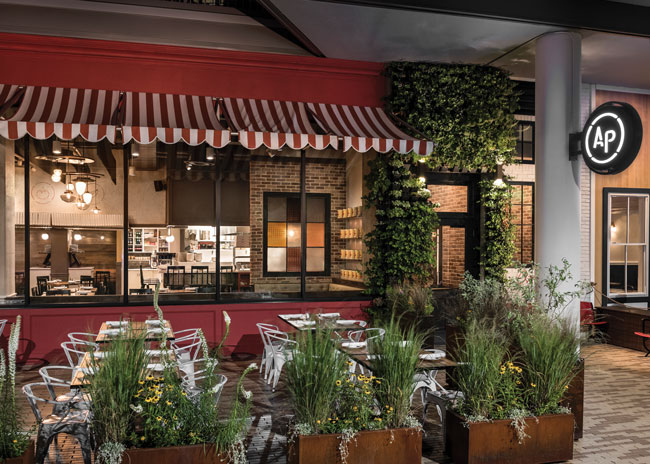 Large front windows at All Purpose pizzeria in Washington, D.C., provide abundant natural light and views to an outdoor seating area planted with seasonal greenery. A living green wall frames the restaurant’s entry. Image courtesy of Amber Frederiksen Photography
Large front windows at All Purpose pizzeria in Washington, D.C., provide abundant natural light and views to an outdoor seating area planted with seasonal greenery. A living green wall frames the restaurant’s entry. Image courtesy of Amber Frederiksen Photography
An Integrated Approach
While plants may lead among first-line approaches to biophilic design, the discipline is much more complex and multifaceted. As Polacek suggests, providing natural light, maximizing views of the outside, using natural materials as well as fabrics, carpet and wallcovering patterns inspired by nature, imagery of nature, water features and organic shapes are all part of a holistic approach to biophilic design.
“There’s a lot more to it than just decorating with plants,” adds Candice Alinovich, designer at Manchester Center, Vt.-based The McBride Company. “When executed well, it’s really about creating a feeling and an experience by connecting with nature. It might be a feeling like you’re on vacation and sitting on a lush terrace, but you’re actually in New York City in the dead of winter. The views are curated, and the architecture guides you through a site and connects you with the natural world along the way. It’s a very sensory approach to design.”
For Jarana, the second Miami restaurant by Peruvian chef Gaston Acurio, Alinovich’s team is working to create the feeling of an indoor-outdoor Peruvian market. Scheduled to open later this year, the restaurant’s design will feature oversized Pisco jar pendant lighting, modern trellis work from which ferns and succulents will hang, fractal patterns, warm woods, and glass walls overlooking outdoor seating areas with natural rattan pendants and a backdrop of tropical plantings.
Alinovich adds that with regard to plants in restaurants, the purest interpretation of biophilic design would always include real plants, but many operators shy away from them due to maintenance concerns. In some cases, she says, silk and other artificial plants can effectively stand in for real, and newer methods of preserving real plants provide more realistic alternatives.
“The question really comes back to ‘how does it make you feel?’” Alinovich says. “If something is to be used in direct view of guests, real is better. But in other applications, if it looks real and evokes that same sort of emotion, then faux can be successful. It’s a better solution than just slapping green on something and saying that it’s biophilic.”
Griz Dwight, AIA, LEED AP, principal and owner at Grizform Design Architects in Washington, D.C., agrees real is preferable, whether used inside or out — and ideally native plant species. But he also believes faux and/or preserved greenery has a place. “There are fake and preserved plants available now that are really beautiful and tough to distinguish from real,” he notes. “Especially for use in restaurants, if they’re positioned strategically, they can provide visual impact and the feeling of connecting with nature without the maintenance, lighting requirements and likely replacement costs associated with real plants. Faux is more expensive, but you can pay now or you can pay later.”
Of the myriad other strategies and materials, beyond plants and their stand-ins, that come into play in biophilic design, Dwight says maximizing views to the outside, indoor-outdoor dining options, natural materials like wood and stone, and nature-inspired wallcoverings are particularly effective.
At All Purpose Pizzeria, a Grizform project in Washington, D.C.’s Anacostia riverfront neighborhood, large factory-inspired windows provide views to a sidewalk seating area planted with seasonal greenery as well as to the river beyond. A living green wall frames the restaurant’s entry.
As for wallcoverings, Dwight says, “There are a lot of really cool designs and patterns now that are inspired by nature. Some are really overblown, in a good way, and add a lot of drama to a space. In our studio, we get into full translation mode, where we may start with something that’s nature-inspired but then it morphs into something else so that it’s subtle. For example, it might be a pattern created by an image of a canary that gets spun on its head until it looks like a flower. But if you look at it closely, it’s still a canary.”
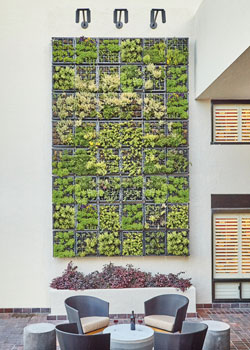 A terrace area outside of Jacks Monterey at the Portola Hotel & Spa features biodiverse living green walls, a live tree, and other plantings as well as natural teak, soothing colors and fire features to create a relaxing seating area. Image courtesy of Jake PerlSuch patterns — whether in wallcoverings, tilework, carpets or other finishes and whether subtle or overt — play a strong role in biophilic design, according to Browning. “We’ve done a fair amount of work around pattern decoration related to the use of biometric forms — forms that mimic nature, natural forms and the use of fractal patterns,” he says. “Galvanic skin response research shows we’re less stressed in environments in which we experience man-made objects and materials with those sorts of patterns. We’re attuned to it because such fractals occur so much in nature. It’s easier for our brains to process them, and we find them pleasing.” +
A terrace area outside of Jacks Monterey at the Portola Hotel & Spa features biodiverse living green walls, a live tree, and other plantings as well as natural teak, soothing colors and fire features to create a relaxing seating area. Image courtesy of Jake PerlSuch patterns — whether in wallcoverings, tilework, carpets or other finishes and whether subtle or overt — play a strong role in biophilic design, according to Browning. “We’ve done a fair amount of work around pattern decoration related to the use of biometric forms — forms that mimic nature, natural forms and the use of fractal patterns,” he says. “Galvanic skin response research shows we’re less stressed in environments in which we experience man-made objects and materials with those sorts of patterns. We’re attuned to it because such fractals occur so much in nature. It’s easier for our brains to process them, and we find them pleasing.” +
A double row of real trees in the lobby of a former DoubleTree Hotel provided a strong biophilic design springboard for the Portola Hotel & Spa in Monterey, Calif. They inspired the designers to simulate nature through colors, materials, lighting and textures to create a sense of place. Image courtesy of Jake Perl
The design for Jarana evokes an indoor-outdoor Peruvian market. It features oversized Pisco jar lighting, modern trellis work from which ferns and succulents will hang, fractal patterns, warm woods, and glass walls overlooking outdoor seating areas with rattan pendants and tropical plantings. Image courtesy of The McBride Company
A terrace area outside of Jacks Monterey at the Portola Hotel & Spa features biodiverse living green walls, a live tree, and other plantings as well as natural teak, soothing colors and fire features to create a relaxing seating area. Image courtesy of Jake Perl
Large front windows at All Purpose pizzeria in Washington, D.C., provide abundant natural light and views to an outdoor seating area planted with seasonal greenery. A living green wall frames the restaurant’s entry. Image courtesy of Amber Frederiksen Photography
14 Patterns of Biophilic Design
Nature in the Space Patterns
1. Visual Connection with Nature
2. Non-Visual Connection with Nature
3. Non-Rhythmic Sensory Stimuli
4. Thermal & Airflow Variability
5. Presence of Water
6. Dynamic & Diffuse Light
7. Connection with Natural Systems
Natural Analogues Patterns
8. Biomorphic Forms & Patterns
9. Material Connection with Nature
10. Complexity & Order
Nature of the Space Patterns
11. Prospect
12. Refuge
13. Mystery
14. Risk/Peril
Source: Terrapin Bright Green

